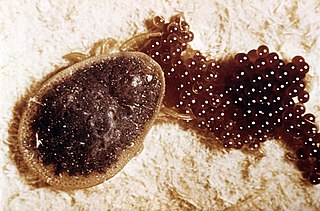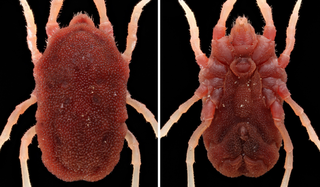 W
WThe Argasidae are the family of soft ticks, one of the two families of ticks. The family contains 193 species, although the composition of the genera is less certain, and more study is needed before the genera can become stable. The currently accepted genera are Antricola, Argas, Nothoaspis, Ornithodoros, and Otobius. The Argasidae are very common in South Asia, along with 96 other species of ticks, making South Asia the region with the highest biodiversity of ticks worldwide. Soft ticks are resistant to desiccation and can live for several years in arid conditions.
 W
WAntricola is a genus of tick containing 16 species. It is very similar to the genus Nothoaspis, which contains the species Nothoaspis reddelliAntricola delacruzi Estrada-Pena, Barros-Battesti & Venzal, 2004 Antricola guglielmonei Estrada-Pena, Barros-Battesti & Venzal, 2004 Antricola inexpectata Antricola marginatus Antricola mexicanus
 W
WArgas is a genus of tick.
 W
WArgas persicus, also known as fowl tick or poultry tick, is a small soft-bodied tick that is found primarily on domestic fowl such as chickens, ducks, and geese. It was first recorded by Lorenz Oken in 1818 in Mianeh, Persia, and named Rhynochoprion persicum.
 W
WOrnithodoros is a genus in the soft-bodied tick family, Argasidae.
 W
WOrnithodoros hermsi is a species of soft tick. It can be infected with Borrelia hermsii.
 W
WOrnithodoros moubata, commonly known as the African hut tampan or the eyeless tampan, is a species of tick in the family Argasidae. It is an ectoparasite and vector of relapsing fever in humans, and African swine fever in pigs.
 W
WOrnithodoros savignyi, known as sand tampan, African eyed tampan or Kalahari sand tampan, is one of some 37 species in the genus Ornithodoros and is a soft tick with a leathery, mammillated integument, causing paralysis and tampan toxicosis, two unrelated conditions. The sand tampan is an ectoparasite on humans, their livestock and wild animals, including birds and bats. Occurring in semi-desert areas of Africa, Saudi Arabia and other parts of the Persian Gulf, India, Sri Lanka and into Asia, it is able to survive for lengthy periods without feeding, spending most of its life burrowed under sand or loose soil, often in wait for animals that rest or sleep under trees or in the lee of rocks, but also in places where people or their animals congregate such as marketplaces, places of worship, cattle kraals and village squares. The timing of its activity is geared to coincide with that of potential hosts, but hot sunny conditions are usually avoided. Because of its habit of feeding and dropping from its host, adult dispersal is limited, whereas larvae may remain attached to their hosts for several days. During its life cycle it will feed on multiple hosts between moults.
 W
WOrnithodoros turicata, commonly referred to as the relapsing fever tick, is a soft tick found in the midwestern and southwestern United States. It is a known vector of Borrelia turicatae, a spirochete responsible for tick-borne relapsing fever in humans. Additionally, vector competence for the transmission of Leptospira pomona, the agent of canine jaundice, has been demonstrated in a laboratory setting.
 W
WOtobius is a genus in the soft-bodied tick family, Argasidae. While similar to the genus Ornithodoros it is characterized by a vestigial hypostome in adults, despite being developed in nymphs, in addition to the absence of both eyes and hood.
 W
WOtobius megnini, also known as the spinose ear tick, is a soft-bodied tick that is only parasitic in the larval and nymphal stages. As its common name suggests, the spinose ear tick's parasitic forms are usually found within the ears of the definitive host. This tick has a worldwide distribution, with common hosts that include horses, cattle, sheep, goats, and dogs.